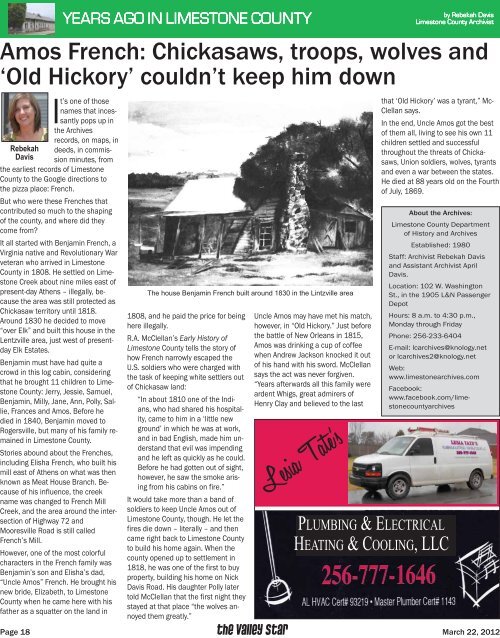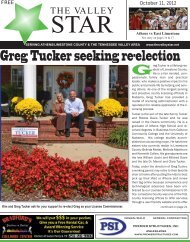STAR - Thevalleystar.net
STAR - Thevalleystar.net
STAR - Thevalleystar.net
You also want an ePaper? Increase the reach of your titles
YUMPU automatically turns print PDFs into web optimized ePapers that Google loves.
YEARS AGO IN LIMESTONE COUNTY<br />
by Rebekah Davis<br />
Limestone County Archivist<br />
Amos French: Chickasaws, troops, wolves and<br />
‘Old Hickory’ couldn’t keep him down<br />
Rebekah<br />
Davis<br />
It’s one of those<br />
names that incessantly<br />
pops up in<br />
the Archives<br />
records, on maps, in<br />
deeds, in commission<br />
minutes, from<br />
the earliest records of Limestone<br />
County to the Google directions to<br />
the pizza place: French.<br />
But who were these Frenches that<br />
contributed so much to the shaping<br />
of the county, and where did they<br />
come from?<br />
It all started with Benjamin French, a<br />
Virginia native and Revolutionary War<br />
veteran who arrived in Limestone<br />
County in 1808. He settled on Limestone<br />
Creek about nine miles east of<br />
present-day Athens – illegally, because<br />
the area was still protected as<br />
Chickasaw territory until 1818.<br />
Around 1830 he decided to move<br />
“over Elk” and built this house in the<br />
Lentzville area, just west of presentday<br />
Elk Estates.<br />
Benjamin must have had quite a<br />
crowd in this log cabin, considering<br />
that he brought 11 children to Limestone<br />
County: Jerry, Jessie, Samuel,<br />
Benjamin, Milly, Jane, Ann, Polly, Sallie,<br />
Frances and Amos. Before he<br />
died in 1840, Benjamin moved to<br />
Rogersville, but many of his family remained<br />
in Limestone County.<br />
Stories abound about the Frenches,<br />
including Elisha French, who built his<br />
mill east of Athens on what was then<br />
known as Meat House Branch. Because<br />
of his influence, the creek<br />
name was changed to French Mill<br />
Creek, and the area around the intersection<br />
of Highway 72 and<br />
Mooresville Road is still called<br />
French’s Mill.<br />
However, one of the most colorful<br />
characters in the French family was<br />
Benjamin’s son and Elisha’s dad,<br />
“Uncle Amos” French. He brought his<br />
new bride, Elizabeth, to Limestone<br />
County when he came here with his<br />
father as a squatter on the land in<br />
The house Benjamin French built around 1830 in the Lintzville area<br />
1808, and he paid the price for being<br />
here illegally.<br />
R.A. McClellan’s Early History of<br />
Limestone County tells the story of<br />
how French narrowly escaped the<br />
U.S. soldiers who were charged with<br />
the task of keeping white settlers out<br />
of Chickasaw land:<br />
“In about 1810 one of the Indians,<br />
who had shared his hospitality,<br />
came to him in a ‘little new<br />
ground’ in which he was at work,<br />
and in bad English, made him understand<br />
that evil was impending<br />
and he left as quickly as he could.<br />
Before he had gotten out of sight,<br />
however, he saw the smoke arising<br />
from his cabins on fire.”<br />
It would take more than a band of<br />
soldiers to keep Uncle Amos out of<br />
Limestone County, though. He let the<br />
fires die down – literally – and then<br />
came right back to Limestone County<br />
to build his home again. When the<br />
county opened up to settlement in<br />
1818, he was one of the first to buy<br />
property, building his home on Nick<br />
Davis Road. His daughter Polly later<br />
told McClellan that the first night they<br />
stayed at that place “the wolves annoyed<br />
them greatly.”<br />
Uncle Amos may have met his match,<br />
however, in “Old Hickory.” Just before<br />
the battle of New Orleans in 1815,<br />
Amos was drinking a cup of coffee<br />
when Andrew Jackson knocked it out<br />
of his hand with his sword. McClellan<br />
says the act was never forgiven.<br />
“Years afterwards all this family were<br />
ardent Whigs, great admirers of<br />
Henry Clay and believed to the last<br />
Lesia Tate’s<br />
that ‘Old Hickory’ was a tyrant,” Mc-<br />
Clellan says.<br />
In the end, Uncle Amos got the best<br />
of them all, living to see his own 11<br />
children settled and successful<br />
throughout the threats of Chickasaws,<br />
Union soldiers, wolves, tyrants<br />
and even a war between the states.<br />
He died at 88 years old on the Fourth<br />
of July, 1869.<br />
About the Archives:<br />
Limestone County Department<br />
of History and Archives<br />
Established: 1980<br />
Staff: Archivist Rebekah Davis<br />
and Assistant Archivist April<br />
Davis.<br />
Location: 102 W. Washington<br />
St., in the 1905 L&N Passenger<br />
Depot<br />
Hours: 8 a.m. to 4:30 p.m.,<br />
Monday through Friday<br />
Phone: 256-233-6404<br />
E-mail: lcarchives@knology.<strong>net</strong><br />
or lcarchives2@knology.<strong>net</strong><br />
Web:<br />
www.limestonearchives.com<br />
Facebook:<br />
www.facebook.com/limestonecountyarchives<br />
PLUMBING & ELECTRICAL<br />
HEATING & COOLING, LLC<br />
Page 18 the valley star March 22, 2012







